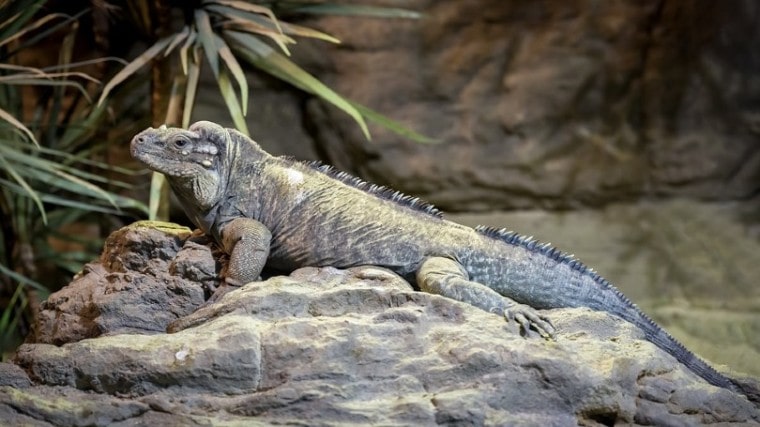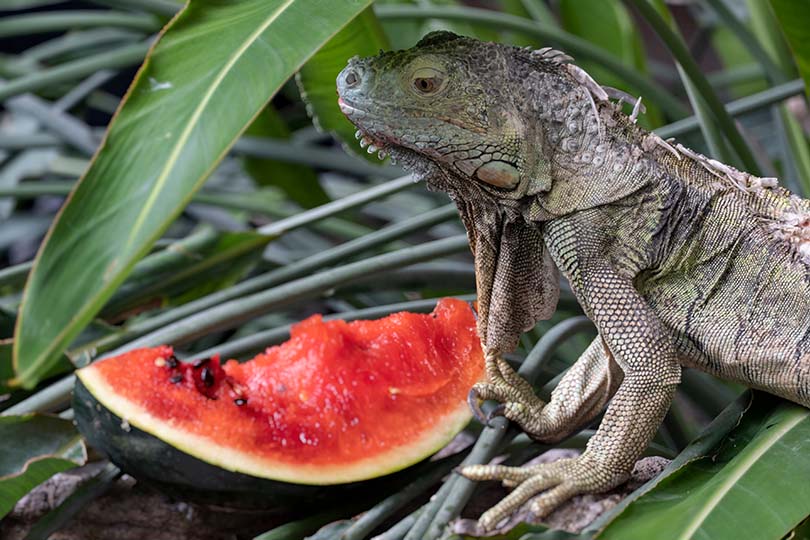
Rhinoceros Iguanas are one of the most popular breeds for prospective iguana owners. Their name comes from the horns on top of their snout, which are reminiscent of their namesake, the rhinoceros. Check out our guide to learn more about the Rhinoceros Iguana and whether or not it is the right pet for you.
Quick Facts about Rhinoceros Iguana
| Species Name: | Cyclura cornuta |
| Family: | Iguanidae |
| Care Level: | Moderate to high |
| Temperature: | 85-90° F (daytime), 70-75° F (nighttime); 100-115° F for basking; humidity ~60% |
| Temperament: | Intelligent, easily tamed |
| Color Form: | Gray, dark green, brown |
| Lifespan: | 15-30 years |
| Size: | 10-20 pounds; 4’-5’ long |
| Diet: | Omnivores; primarily vegetation, occasionally insects and small mammals |
| Minimum Tank Size: | 8’ x 4’ x 3’ |
| Tank Set-Up: | Requires both a warm area for basking and a cooler area on opposite sides of the enclosure; substrate that holds humidity such as coconut fiber |
| Compatibility: | Best housed alone; don’t place two males together |
Rhinoceros Iguana Overview

The Rhinoceros Iguana, or Cyclura cornuta, is a species of iguana that is found primarily on the island of Hispaniola. The Rhinoceros Iguana is one of the largest species of iguanas found in the Caribbean, reaching up to 5 feet long and weighing up to 20 pounds. There have been two known subspecies of Rhinoceros Iguana: the Navassa Island Iguana and the Mona Ground Iguana. Both species originated in the Caribbean. The Navassa Island Iguana, first studied in 1885, is thought to be extinct due to military occupation on Navassa Island in the first half of the 20th century. The Mona Ground Iguana, native to Mona Island in Puerto Rico, is not yet extinct, but it is considered to be endangered.
In captivity, the Rhinoceros Iguana can live as long as 30 years, making them wonderful long-term companions. While these iguanas are less social than other types of pets, taming them to be friendly with humans is relatively easy. However, if you are looking for a low-maintenance pet, you are unlikely to find one in these iguanas; they require a specific, regulated environment and need to eat a high volume of food in order for their nutritional needs to be met.
How Much Do Rhinoceros Iguanas Cost?
If you plan to purchase a Rhinoceros Iguana, you can expect to pay between $500 and $600. They are fairly expensive because these docile, easily trained iguanas make popular pets. Beyond the initial cost of purchasing your iguana, you need to consider the costs associated with preparing an adequate enclosure. As these iguanas can be quite large, they need a large enclosure. You can expect to pay several hundred dollars to set up your pet’s habitat.
Typical Behavior & Temperament
Rhinoceros Iguanas are generally docile creatures, but if they feel threatened, they can become aggressive. Be aware that these reptiles have very strong jaws that can inflict serious injuries. They will also strike with their tails. Males can become aggressive and assert their dominance—particularly during mating season.
Over time, you can train your Rhinoceros Iguana to trust you enough to pet him. One way to do this is to offer him food with tweezers as a bribe. Let your iguana come to you instead of rushing to pet or pick it up. Don’t approach him from above or you may startle him; instead, let him see you and approach him from the side.

Appearance
In addition to its characteristic “horns,” the Rhinoceros Iguana can be distinguished by the spines running down its back. The horns on male Rhinoceros Iguanas are larger than those of females. Males are also larger than females. These reptiles can range in color from gray to dark green or brown.
How to Take Care of Rhinoceros Iguanas
Habitat, Tank Conditions & Setup
Your Rhinoceros Iguana enclosure should be relatively large to accommodate this large breed. At a minimum, you need to provide your iguana with an enclosure that is 8’ W x 4’ D x 3’ H. You will need to meticulously arrange the enclosure so that your iguana has both a basking area and a cooling area.
Rhinoceros Iguanas are indigenous to areas with warm, humid climates, so they require a habitat that can successfully mimic these conditions. For substrate, you should use a material that will be able to hold water efficiently, such as coconut fiber, so that you can maintain humidity in your iguana’s enclosure. In the basking area, the Rhinoceros Iguana requires high heat—the temperature should be somewhere between 100-115° F. The rest of the enclosure should be around 85-90° F during the day, and around 70-75° F at night. You will want to put a thermometer in the enclosure so that you can monitor the temperature and make sure it is suitable.
If you live in a warm climate, you should consider putting your iguana’s enclosure outdoors. Being outdoors will vastly improve your pet’s quality of life and give him exposure to natural sunlight. However, if you live in a cool climate, it will be difficult to maintain the warm temperatures your iguana needs, so you may want to consider keeping the enclosure inside your home if you have the space. You should use a UVB lamp, especially if your enclosure is indoors so that your iguana can create vitamin D3, an essential vitamin that helps your iguana build strong bones.

Do Rhinoceros Iguanas Get Along with Other Pets?
Generally speaking, Rhinoceros Iguanas should be kept in an enclosure by themselves. However, they can be kept with other iguanas as long as you don’t have two males in the same enclosure. As stated, male Rhinoceros Iguanas can become aggressive and try to display their dominance when they are around other males, especially during breeding season. You can tell your male Rhinoceros Iguana is trying to assert its dominance when it starts gyrating and bobbing its head.
What to Feed Your Rhinoceros Iguana
Rhinoceros Iguanas are primarily herbivores, although they do occasionally eat insects. Their diet should be made up of primarily vegetables and vegetation, along with the occasional fruit. Peppers, dandelions, mustard greens, squash, okra, papaya, pears, and many other types of plants are wonderful options for your iguana. Take care to ensure that there isn’t any substrate under his food container, as ingesting it could lead to digestion issues.
In terms of how much food to give your Rhinoceros Iguana, you should keep in mind that a primarily vegetarian iguana needs a lot more food than a carnivorous reptile in order to meet its nutritional requirements. You can give your iguana as much food as he is able to eat and remove any food they don’t eat within a few hours of feeding time. You should plan to feed your iguana daily, though you don’t need to feed him all of the different types of plants listed above on a daily basis. Feed him greens each day, vegetables about every other day, and fruits up to three times per week.

Keeping Your Rhinoceros Iguana Healthy
In addition to feeding your Rhinoceros Iguana a varied diet and ensuring that he gets UVB light that will help him get vitamin D3, you should consider adding some dietary supplements to prevent your iguana from developing a deficiency. You can sprinkle a calcium supplement on greens and mix them in before feeding them to your Rhinoceros Iguana.
Your Rhinoceros Iguana also needs constant access to clean water. You should provide him with a large bowl of water, changing it frequently and cleaning it with a disinfectant that is safe for reptiles. You may need to clean it more often if feces or other debris gets into the bowl.
Breeding
Male Rhinoceros Iguanas reach sexual maturity at around 4-5 years of age. Females reach sexual maturity earlier, at around 2-3 years old. Iguana breeding season takes place between March and June, so if you are planning to breed your iguanas, it would be ideal to introduce the individuals that you are hoping to mate at that time. You can keep male and female Rhinoceros Iguanas together for a longer period of time to give them a chance to bond and increase the likelihood of mating.
Once your Rhinoceros Iguanas have mated and your female iguana lays her eggs, she will be very protective of her nest and may even try to attack her caregiver if they get too close. Make sure to give her plenty of space while the eggs incubate, which can take 4-5 months.
Are Rhinoceros Iguanas Suitable for You?
Overall, Rhinoceros Iguanas can make great pets. However, if you’re looking for a low-maintenance pet or an animal that will enjoy being held by humans, you may want to consider other options. These animals require a high level of care to ensure that they receive the best quality of life possible. That being said, they are one of the friendliest and most docile iguana species out there, which means they can be a great addition to your home if you have the time, space, and money to properly care for them. If you are looking for a pet reptile to add to the family, the Rhinoceros Iguana could be perfect for you.
Related Reads:
Featured Image Credit: Bergadder, Pixabay








